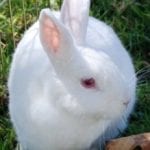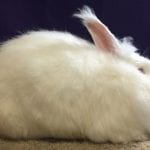Scientific Facts
| Common Name: | German Angora Rabbit |
| Life Span: | 7 to 12 years |
| Size: | Medium to Large sizes |
| Country of Origin: | Germany |
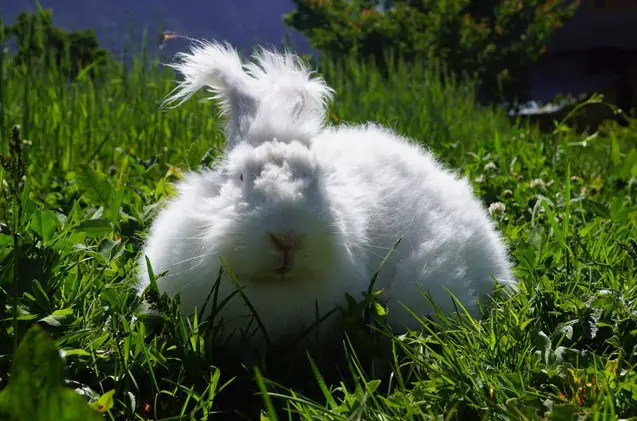
Physical Description
Other than their captivating coats, German Angora rabbits are widely known for their alluring fixtures found in their faces and also their ears, normally named as tassels. These creatures have well-haired and upright ears, with bunches of hair above. Perceived to be large in size, these rabbits have a weight that is around 5.5 to 12 pounds. Their bodies are well-proportioned and are in round shape, having similar height and width, and of average length.
All Angoras are adored mainly for their soft fur; however, German Angoras surpass its entire relatives. These rabbits have very nice hair – woolen, very exquisite, and long. Although Angoras commonly possess delicate fur, this variety is famous for the uncomplicated maintenance of the coat. Their fluffy hair does not cast off because they carry the non-shed gene. German Angoras have a fur that is exceptionally invulnerable to matting, and they do not require grooming or brushing. Nevertheless, these creatures have to be shaved every three months. Their wool may be twirled into yarn because their bearing is bountiful, and the hair quality is excellent.
These rabbits are unique in a way that they haul three segregated wool fibers. They have heavy, silky, nicely curled undercoat, and has to be pleasantly long. Their awn fluff is intermediary fibers, lengthier than the undercoat, slightly curled, and consistently have a crooked tip. Its tip will curve on its own even after shaving. Their awn hair is also considered as guard hair. The hair is straight, which extends further the range of other fibers. It is also more enduring. An ideal proportion between these three segregated wool fibers will lead to the correct texture of the wool.
German Angora Rabbits appear in entirely homologous colors; however, the most typical is the ruby-eyed white rabbit or REW. On the assumption of colored rabbits, their coat is never uniformly colored. They always have the duller undercoat as compared to the top section of the fur, which emerges in a more profound, dynamic hue. Patterns or markings of the coat are peculiar because they are not permitted in breeding guidelines, and, in essence, deliberated an unpleasant characteristic.
Lifespan
German Angora Rabbits have a lifespan of 7 to 12 years if they are raised indoors and provided that they are properly cared for by their owners.
Eating Habits
German Angora Rabbits should be fed with hay and pellets up until the age of 4 to 6 months. After that, these creatures become adults, and their diets would need to be reduced.
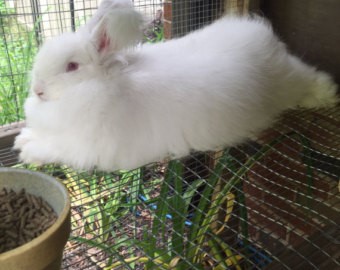
Sleeping Habits
German Angora Rabbits are characterized as crepuscular. This implies that they are most energetic during dawn and dusk. One of the unfavorable aspects of these pets for kids is that their sleeping habits could indicate that frequently the kids sleep during the hours when these rabbits are awake, who happen to sleep the entire day. If defied by the kids during their come back from school, the rabbit might attack. Although many will not vigorously assail or intentionally injure the kids, however, in their apprehension, they are likely to seize because their pattern of sleep is being hampered.
Development and Reproduction
The female German Angora Rabbits are extremely fertile. They can deliver a good volume of kittens. Their kits would tend to grow rapidly, making them great for commercial bunny farming.
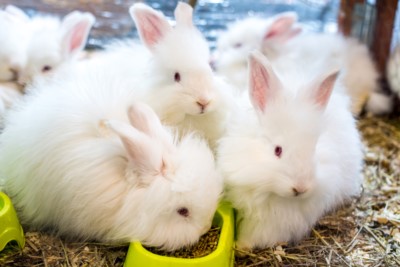
How to Breed
Determining the Sexes
German Angora Rabbits are born either with a vagina or a penis. Nevertheless, their genitals are concealed through a vent opening, and they are not yet completely mature, which makes it hard to determine where the baby is a male or female. Allow 6 to 8 weeks to figure out the sex. Firmly handle the rabbit with one hand in its back. Gently turn it on its rump. Gently pull the tail outward using your forefinger and your second finger. Press down the belly through your thumb enough just over the vent area. Notice two openings. One closest the rear would be the anus, and the one nearest the abdomen would be the genitalia.
An upright slit above and near to the anus tells that the rabbit is a female. A circling dot in this area would be the opening of the penis’ tip.
Courtship and Mating
Unsprayed females are likely to hollow out to make breeding dens and shall shield their holes through actions like charging, scratching, or biting. The male German Angora Rabbits can be assertive too and may grip, knurl, or bite the arm of a human due to sexual disappointment. Males also have the tendency to sprinkling their cage with urine and the surrounding of the house to demonstrate their territory and declare their appearance to any females that are near the area.
Breed following molting if their fur is short and curtails the superfluous fur nearby its belly areas and genital. This shall guarantee effortless mating. The short fur shall also lead to easier breastfeeding, and guarantee that the doe shall not have long fur, which it might pull out and utilize to line its nest box. It will not be safe for the doe to have long fur because kits might get tangled.
The gestation period of German Angora Rabbits is between 31 to 33 days.
Common Health Problems
GI Stasis
Knowing that German Angora Rabbits have abundant and fluffy coats, they often ingest plenty of their hair while they are grooming themselves. This behavior often leads to a wool block, which is commonly attributed to GI stasis. This condition is fatal and truly life-threatening. The rabbit may not be able to heave the fiber from the stomach, and a huge accumulation may block its intestines and digestive system. Once this happens, you will notice your pet to stop in feeding, and it will also stop drinking water. If you do not do anything to rescue your pet from this condition, there is a tendency that it will die due to not eating.
This is the reason why it is important to notice it in the early stage. Sadly, this implies that you will have to exert more attention on the poop of your pet. A definite indication of a wool block, other than its loss of appetite, is when its feces become dry and very small.
The most common symptom of GI stasis is constipation, little, and dry poop. Once you figure out any of these manifestations in your pet, you have to bring your German Angora to a veterinarian. An ideal approach to evade wool block is to feed your pet plenty of roughage and shave your pet at least every three months. You may also give your rabbit some pineapple juice mixed with water or mineral oil because it works in heightening stomach enzymes. If the German Angora Rabbit refuses to drink water, you may have to provide it water through the use of a syringe.
If all these remedies are seen to be not working, and if the situation goes extreme, the veterinarian can handle your pet and feed it within the vein. Wool blocks can be terrifying; hence, you have to monitor your rabbit because if it is figured out early, this condition can be reversed.
Ear Mites
If you notice your pet to have a formation of friable material within the ear canal, then there is a big chance that your rabbit has ear mites. Rabbits that are free from ear mites should have clean ears and should have no discernible debris. There are ear mite drops available over-the-counter, and it can be placed in their ears once per week until the ear mites have flown. However, if you have been raising your rabbit the natural way, you can use organic olive oil combined with little drops of neem oil applied in the ears once a week until such time that the mites are totally gone. Just make sure that you securely hold the rabbit. It will be more doable if you get someone’s help. You would prefer the treatment to penetrate the ear as deep as possible. Once used, squeeze it mildly to the ear to help spread the treatment as smoothly and deeply as possible, then stay back. The moment you let you your pet, it will shudder its ears in an attempt to get rid of the treatment. Prepare a cloth for you to wipe any excess. If formulating your organic treatment, purchase an unfilled ketchup squirt bottle because this will help in squeezing oil in the ears of the rabbit.
Overgrown Teeth
The hay isn’t only ideal for the German Angora’s diet for its assistance to the digestive system. The teeth of a rabbit grow all through its lifetime. Nibbling on hays shall help scrape the teeth down.
Worms
German Angora Rabbits can acquire worms. To prevent the worm from penetrating your pet, you may consider adding DE (Diatomaceous Earth) to the pellets. Simply add enough to slight coat the rabbit pellets. Putting a DE to a new pack of pellets is the simplest instead of adding it to every feeding. You can purchase DE on any feed stores, or you may also buy online.
Preventing Illnesses
Except if you are thinking of breeding your pets, having them neutered or spayed is something worthy to consider. This conventional process may have astounding advantages to the personality and the health of your German Angora Rabbits. Neutering or spaying your pets will reduce the hazard of cancer and illnesses that impact the reproductive organs and get rid of their inclination to imprint the territory using urine.
Behavior
German Angora Rabbits are affectionate and naturally sweet. They enjoy playing with their handlers. If properly socialized, starting at their young age, German Angora Rabbits will make superior pets. Considering their soft fur, these creatures are acquainted with human touch and grooming; thus, they do not mind being cuddled. They cherish every moment they spend with their handlers. These creatures easily get overheated. Understanding this, you will appreciate the significance of their huge ears. The ears serve as air conditioners, which help the rabbits retain normal body temperature. Their ears have huge blood vessels that are very near to the skin surface. While the temperature in the rabbit rises, excess heat of the body disperses from those veins, which let the rabbit cool down.
These creatures are very smart and playful. With just a minimal effort accompanied by patience, you may even train this pet to come near you when being called. You can also teach your pet to use a litter box. You will also notice that these rabbits are not too dynamic and aggressive. They get contented with snoozing in their comfortable enclosure until their time to play arrives.
Because German Angora Rabbits do not cast off and have an overall sociable personality, they make a great choice for any families with children. These rabbits are not inclined to scratching or biting. They enjoy cuddles, and there is no danger of young kids swallowing hair.
Habitat
Enclosure
If you intend to keep your rabbit indoors, you have to secure a cage. You have the option to build your own cage or buy it. The enclosure should be in a suitable size to make sure that your German Angora will feel comfortable. The crate must be huge enough so the rabbit can stand through its hind legs and candidly walk around. The hutch must have a dimension of at least 36 x 24 x 18 inches. It should have a tray beneath the wire floor to capture the droppings and the urine, which will keep the fur from being dirty. Different from other rabbits, these creatures will rarely perceive the wire floor because of their feet that are well-equipped with hair. The enclosure should have a bottom that is padded with rabbit-safe bedding, and it should be replaced periodically to sustain the cleanliness within the enclosure. Cages have to be cleaned every two days since an excessively dirtied cage can be very disturbing to your pet because of the odor caused by the urine. Avoid putting two or more rabbits in one cage, except if they came from similar litter and they are still at their young age, because they may act very territorial.
The needs for outdoor enclosures are similar, except that the owner will have to give the rabbit the protection against its potential predators and utmost temperatures too. You should keep the cages away from the ground and see to it that they are durable enough to endure an attack of a predator. Again, it is important that you secure your rabbit a shed from the weather when there is heat, rain, and snow. These creatures do well in the cold. During summer, the rabbit should be placed somewhere that is well-ventilated.
Toys
German Angora Rabbits love to have fun. They want something that would make them entertained. Giving them toys shall give them great pleasure. There are plenty of choices when talking about rabbit-safe toys. Wooden blocks, balls, chew sticks, pumice blocks, cardboard tubes, apple sticks, mini pine cones, branches, and twigs are great toy selections for your pet. Bear in mind that these rabbits will gnaw on the toys; hence, it is essential that you check for the safety of the toys you will be giving.
Giving your German Angora Rabbit toys for it to chew shall secure the additional advantage of helping trim the teeth. If you do not secure your rabbit a lot of stuff to chew, its teeth can continuously grow, which may lead to serious health issues demanding the expertise of a veterinary. Toys such as balls are perfect recreations for rabbits.
Diet
The most significant thing in caring for a German Angora Rabbit is feeding. These creatures demand additional protein to reinforce a regular production of wool. The ideal method is to feed them 18 percent commercial rabbit protein pellets, which is available in any pet store. Rabbits can be given treats once a week. There is no need to give those treats more often. You may serve them vegetables and fruits such as papaya, banana, and broccoli. This will give them a healthy digestive system, and it also inhibits wool block.
Understanding the fact that the digestive system of baby angoras is fragile, you have to begin serving them with treats once they reach the age of 4 to 6 months. Papaya tablets are available in health food stores, and they can inhibit wool block. You may serve them 2 to 5 tablets once per week.
Aside from the food, owners should also have to make sure that there is available freshwater for the rabbit every day.
How to Care for German Angora Rabbit
German Angora Rabbits only require a bit of extra effort to keep healthy and pleased. The most fundamental care necessities are their grooming needs and diet. When feeding these rabbits, they shall gladly munch on fruits, vegetables, and rabbit pellets. However, the superiority of their diet requires to have hay. Roughage like hay assists Angoras with wool block, and it is a concern that disturbs the German variety even more. While they bear plenty of wool, it will be reasonable to conclude that a large volume of their hair wind up in the digestive system as they are tending themselves.
These creatures can either be kept outdoors or indoors. In any case, the environment of their living should be secure and convenient. If you intend to bring a German Angora in your home, it would be important to secure an enclosure that has a suitable dimension. If you allow your rabbit to go outdoors, you will have to supervise your pet the entire moment that it is out from its enclosure. Let them play but only in the fenced portions of your yards, where no animals can injure them and where they cannot get wandering. Other than their enclosures, these rabbits long for playtime with you.
While they are indoors and playing, see to it that there are no valuables or electric cables exposed anywhere. Remember that your pet enjoys nibbling on kinds of stuff, and there is plenty of stuff in a house that may critically injure the German Angora if it bites on them.
Their diet should be healthy. It should consist of hay and excellent quality rabbit pellets. They may also eat vegetables, fruits, and certain greens that are rabbit-friendly.
Where to Get?
If you are planning to get a German Angora Rabbit, you need to be aware that the IAGARB Standard allocates 45 points on the wool of the Angoras which includes the length, density, uniformity, and texture and the rest of the 55 points are allocated to their overall condition and their body type.
There are plenty of potential places where you may obtain this pet, including rescue centers. Rabbit breeders are also selling this breed. Nevertheless, you should always consider the trustworthiness of your seller when you have finally decided to get a German Angora Rabbit. The sincerity of the seller should be the primary consideration.
FAQs
Should I allow my kids to play with our German Angora Rabbit?
German Angora Rabbits are great for any family, even if these families have kids. Children are welcomed to play with German Angora. However, before you allow your kids to interact with your pet, see to it that you are able to properly explain to them the proper way of playing with your rabbit. You should also discuss to your kids how to cuddle your rabbit without getting it hurt.
Are German Angora Rabbits nocturnal?
No. These rabbits are crepuscular, which means that they are commonly energetic during dawn and dusk.
How do I keep my German Angora Rabbit from feeling bored?
Similar to humans, these creatures need some socialization. They need a space wherein they can exercise. You can give your pet a lot of toys to keep it entertained. You may load a cardboard oatmeal canister or a paper towel with hay to let your rabbit roll, gnaw, and play with its utmost desire.
